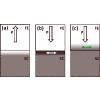当前位置:
X-MOL 学术
›
Phys. Rev. B
›
论文详情
Our official English website, www.x-mol.net, welcomes your feedback! (Note: you will need to create a separate account there.)
Polarization-controlled modulation doping of a ferroelectric from first principles
Physical Review B ( IF 3.7 ) Pub Date : 2018-03-20 00:00:00 , DOI: 10.1103/physrevb.97.094107 Xiaohui Liu , Evgeny Y. Tsymbal , Karin M. Rabe
Physical Review B ( IF 3.7 ) Pub Date : 2018-03-20 00:00:00 , DOI: 10.1103/physrevb.97.094107 Xiaohui Liu , Evgeny Y. Tsymbal , Karin M. Rabe

|
In a ferroelectric field effect transistor (FeFET), it is generally assumed that the ferroelectric gate plays a purely electrostatic role. Recently it has been shown that in some cases, which could be called “active FeFETs,” electronic states in the ferroelectric contribute to the device conductance as the result of a modulation doping effect in which carriers are transferred from the channel into the ferroelectric layers near the interface. Here we report first-principles calculations and model analysis to elucidate the various aspects of this mechanism and to provide guidance in materials choices and interface termination for optimizing the on-off ratio, using (electron-doped ) and as prototypical systems. It is shown that the modulation doping is substantial in both cases, and that the electrostatic model developed in previous work can be used to predict electron transfer. This model can thus be used to suggest additional materials heterostructures for the design of active FeFETs.
中文翻译:

基于第一原理的铁电体的极化控制调制掺杂
在铁电场效应晶体管(FeFET)中,通常假定铁电栅极仅起到静电作用。最近发现,在某些情况下,可以称为“有源FeFET”,由于调制掺杂效应的作用,铁电体中的电子态有助于器件电导,其中载流子从沟道转移到附近的铁电体层中接口。在这里,我们报告第一性原理计算和模型分析,以阐明该机制的各个方面,并在材料选择和接口端接方面提供指导,以优化开/关比。 (电子掺杂 ) 和 作为原型系统。结果表明,在两种情况下调制掺杂都是很重要的,并且先前工作中开发的静电模型可用于预测电子转移。因此,该模型可用于建议用于有源FeFET设计的其他材料异质结构。
更新日期:2018-03-20
中文翻译:

基于第一原理的铁电体的极化控制调制掺杂
在铁电场效应晶体管(FeFET)中,通常假定铁电栅极仅起到静电作用。最近发现,在某些情况下,可以称为“有源FeFET”,由于调制掺杂效应的作用,铁电体中的电子态有助于器件电导,其中载流子从沟道转移到附近的铁电体层中接口。在这里,我们报告第一性原理计算和模型分析,以阐明该机制的各个方面,并在材料选择和接口端接方面提供指导,以优化开/关比。 (电子掺杂 ) 和 作为原型系统。结果表明,在两种情况下调制掺杂都是很重要的,并且先前工作中开发的静电模型可用于预测电子转移。因此,该模型可用于建议用于有源FeFET设计的其他材料异质结构。



























 京公网安备 11010802027423号
京公网安备 11010802027423号